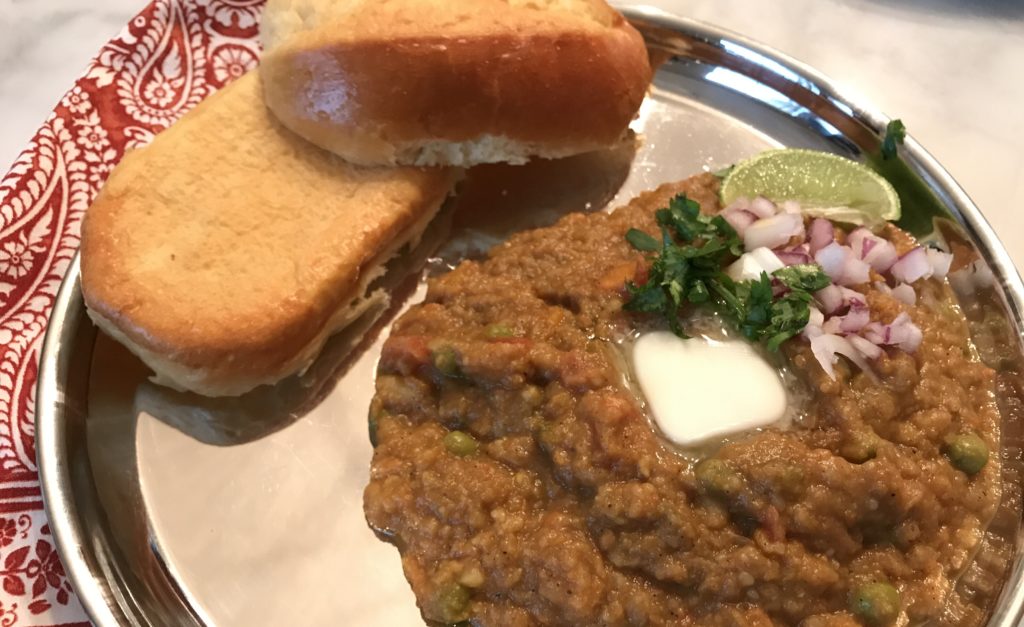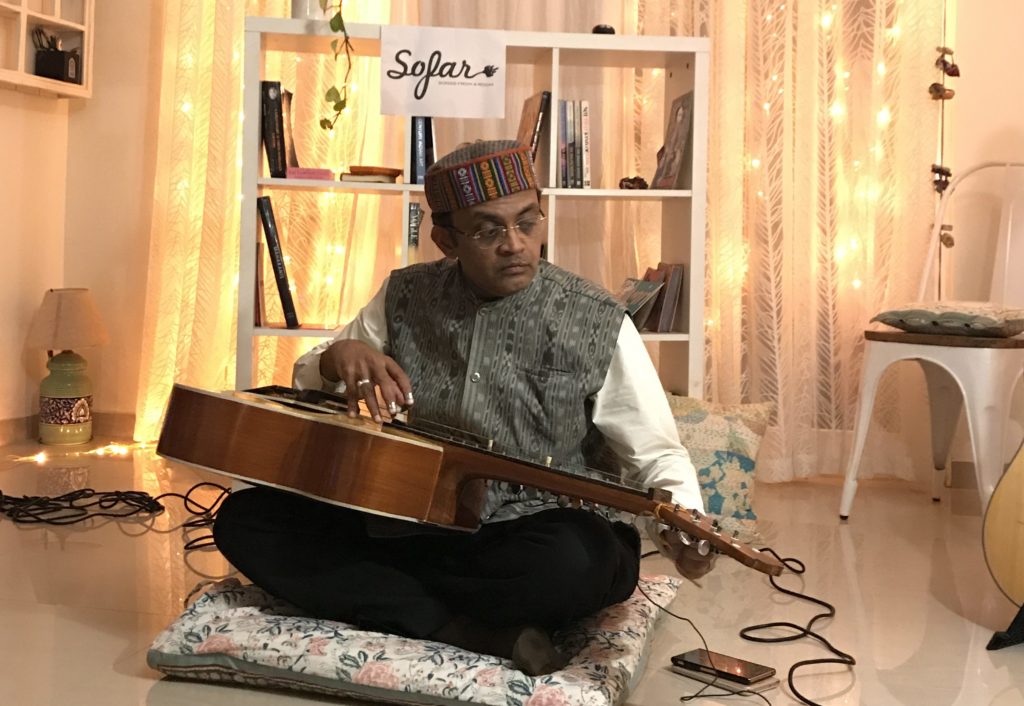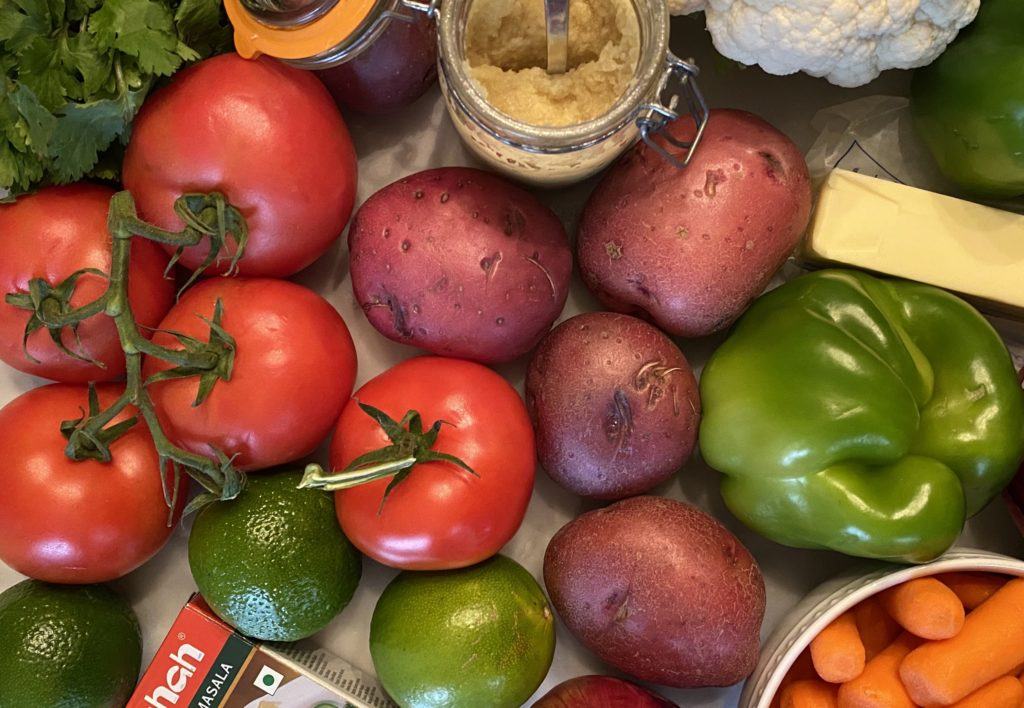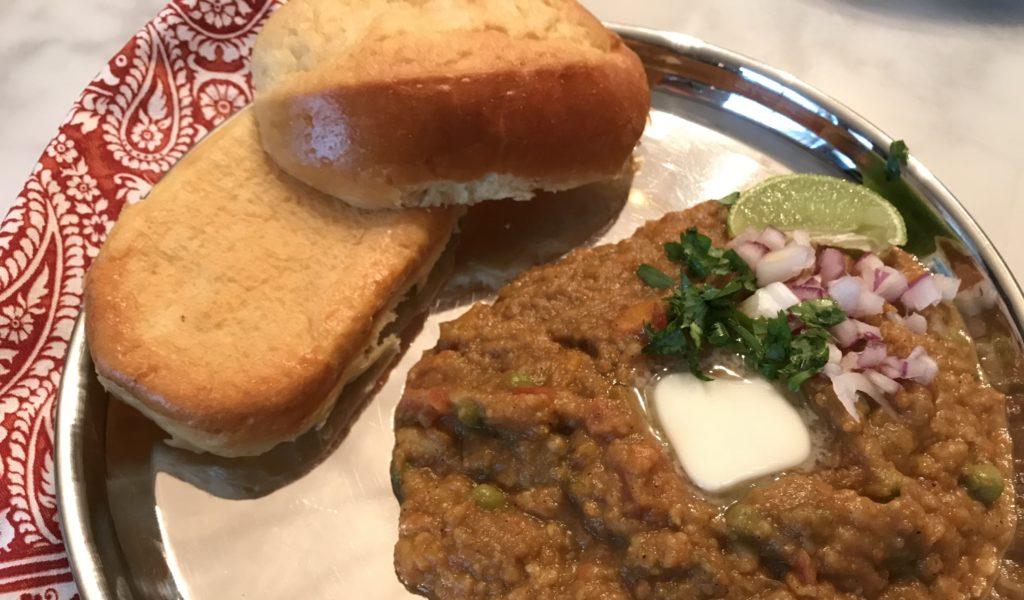The storied origins of both a beloved Mumbai street food, and a patented slide-steel guitar with sympathetic strings, and opportunity to taste, hear and experience both.
story
Origin of this Portrait
I first tasted Pav Bhaji in 2003, at the table of a coworker in New Jersey (Thanks, Jagruti!), and it has been a favorite ever since. Thankfully she shared her recipe because amazingly it’s not even in a single one of the 11 Indian cookbooks we have at home, though of course there are plenty of recipes online.

After having making it for years and tweaking it to our taste along the way, this week my husband couldn’t stop telling me how delicious it was, so we decided it was time to note the recipe and the music and stories which accompany it at our table each time we make a big pot to share with friends (or stash extras in the freezer).
music
Jaiwant Naidu
I was lucky enough to catch Jaywant Naidu at a SoFAR Hyderabad show in August 2017. His sound was wonderful and I was amazed to learn he even invented his own guitar, aptly named the Jayvant guitar.

One fine evening in Brooklyn, when looking for songs to accompany the famed Pav Bhaji, I was thinking of musicians from Mumbai and I thought of Jaiwant because although he grew up in Hyderabad, I remember him telling us that he studied music in Mumbai.
Fondly recalling his story and his sound, I put on his music while I cooked, and later while eating with my family, I delighted in sharing the above story of his patented guitar with my kids… and now Pav Bhaji and Jaiwant Naidu are forever paired in our home. We can not eat Pav Bhaji without his music, and recalling the story of his guitar, particularly when there are guests at our table who do not yet know about him.
Please enjoy this video so that you can see you can see as well as hear his genius. Find additional videos on his YouTube page and subscribe so that you can stay up to date with new videos as he posts them!)..
story
The Jaiwant Guitar
The night I first heard him perform in Hyderabad (August 2017), I was fascinated to learn that the guitar he was playing was his own, patented invention, aptly named the Jaywant Guitar.
In short, it’s a Hawaiian steel guitar outfitted with extra strings, lending an incredible depth of sound (not unlike that of a sitar). His guitar has a total of 21 strings (6 main strings, 12 sympathetic, and 3 Taraf), resulting in a sound that combines the Veena, Sarod, Sitar and Sur Bahar.
He tells the story of it, from dream to creation, in this TEDx video:
You can also read more of his story in this piece in The Hindu. From trying out classical Indian instruments and even voice, to using part of a table fan as a slide because it fit his finger better, it was clear Jaywant was going to pave his own way.
story
Birth of Pav Bhaji
Being quite unlike many other Indian dishes I’ve come across (large selection of mashed up veggies and served with what seems like hamburger buns), I’d always been curious about the origins of Pav Bhaji. From asking fellow diners over years of eating and cooking it, I knew that Pav (or Pau) meant bread, and bhaji meant fried (yet this is not to be confused with bhajis (as in mirchi bhajis or onion bhajis, which are fritters of various veggies covered in gram flour and enjoyed with Maggi Hot & Sweet Tomato Chilli Sauce, of course) … but beyond that I wasn’t able to find out to many details..
Eventually, curiosity lead me to Google. The consensus is that was born in 1850s outside the cotton mills of Mumbai, when in the middle of the night, workers were getting out of long shifts (supposedly to support US Civil War needs), and traders were waiting for prices to be announced… and all of the above were hungry! As the story goes, industrious folk took the days left overs, mashed it up in cooked tomatoes, added masala and served it with bread toasted on a tawa, which was quicker and easier than making the typical Indian breads.
This Hindustani Times piece pays homage to the Portuguese for bringing that particular type of pav (note that pao = bread in Portuguese) to India, and mentions a book I’ll need to check out: “Curry: A Tale of Cooks and Conquerors” by Elizabeth Collingham.

Buttery bread aside, it’s chock full of all sorts of veggies that some of the more picky among us might not be interested in on their own, but mushed up together with masala – oh my is it yumbos!
music
Playlist
For when you’re away from your screen and hopefully cooking up a big pot of Pav Bhaji, here is your free Spotify playlist.
recipe
Pav Bhaji
Pav Bhaji is certainly an all-time favorite in our home, and one that is not only relatively quick and mostly hands-off but can yield a big pot fit to share with friends, and/or freezing leftovers (always better the next day when flavors meld a bit more).

Don’t let the long list of ingredients and steps intimidate you! It’s actually very simple, especially if you have a pressure cooker (and aren’t afraid to use it). It makes enough for 4 hearty dinners for 4. We’ll usually eat that day, have leftovers a few days later, and I’ll have frozen 2 quart containers for another day.
Pav Bhaji
Ingredients
Bhaji
- 1 large head of cauliflower, in 2.5 inch pieces
- 5-6 small/medium red potatoes, in inch pieces
- 1 lb carrots, peeled and chopped into 1 inch chunks
- 1 big green pepper, finely diced
- 5 tbsp ginger garlic paste
- ½ tsp turmeric
- 5 tbsp butter, divided
- ½ tsp chili powder
- 4-5 tomatoes diced small
- 1 tsp salt or more to taste
- 3 tbsp Pav Bhaji masala or more to taste
- 1 pint frozen peas
Serve With
- Brioche Rolls
- salted butter to toast the buns
Garnish
- red onion, finely diced
- cilantro, chopped
- lime wedges
- butter
Instructions
- Wash/chop/peel potatoes, carrots and cauliflower. Don't get too caught up in the amounts of each here.
- Put the potatoes, cauliflower and carrots in a large pressure cooker with 2 cups of water, cover and set to high. When it reaches high pressure, reduce heat a bit and cook for 5 minutes, then turn off the heat and allow the pressure to release naturally. (If using a regular large stock pot, expect to use more water, and more cook time for the vegetables to get soft.) Meanwhile, chop the green pepper into a small dice.
- Heat a large sauté pan to medium, add 3 tbsp butter and when foaming subsides, sauté the green pepper, stirring frequently so it doesn’t burn. Meanwhile, chop the tomatoes into a small dice and keep aside.
- When the pepper is soft and begins to brown (can be 10-15 mins or more), add ginger-garlic paste and sauté for a few minutes until fragrant. Then add chili and turmeric, continuing to stir. After a minute, add the chopped tomatoes to the peppers and cook until it all begins to meld into one sauce, adding a bit of water if it begins to stick to the pan. Meanwhile, carefully open the pressure cooker and coarsely mash the cooked cauliflower-carrot-potato mixture with a potato masher, and keep aside, covered and warm.
- When the pepper/tomato mixture is ready, add it to the pot of mashed vegetables and combine. When the mixture begins to boil, lower the heat and add Pav Bhaji masala and remaining 2 tbsp (or more!) of butter. Simmer for 5 mins and add peas. When it returns to simmer, taste and adjust salt, Pav Bhaji masala and butter as needed. Don't be shy about the butter!
- Meanwhile, prepare the garnishes. If you can let it sit for a while after that, you will be rewarded with added deliciousness for your patience. If you wait for the next day, it's next-level good.
Enjoy
- When ready to eat warmed pav bhaji, prepare the toasted pav (they are best fresh and warm). Cut the rolls (if needed) as if you were making a sandwich. Heat a nonstick pan to medium, melt butter, and place the rolls cut side down onto the buttered pan, fitting as many as possible. Cook until it is toasted to a nice golden brown, twirling it a bit too evenly toast.Serve immediately with Jaiwant Naidu on the speakers, and garnished as noted.
Bonus
Time Lapse: Tunes + Cooking
Lastly, a Bonus update: the quick timelapse video of a big pot of Pav Bhaji cooking February 2019, demonstrating how the music of Jaywant Naidu is an important part of our Pav Bhaji recipe, infusing his sounds into the tastes of this delicious dish.